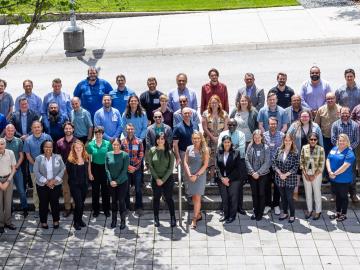
Filter News
Area of Research
- Advanced Manufacturing (3)
- Biology and Environment (31)
- Building Technologies (1)
- Clean Energy (39)
- Climate and Environmental Systems (1)
- Computational Biology (1)
- Computational Engineering (2)
- Computer Science (12)
- Fuel Cycle Science and Technology (1)
- Fusion and Fission (3)
- Fusion Energy (2)
- Isotopes (20)
- Materials (28)
- Materials for Computing (5)
- Mathematics (1)
- National Security (38)
- Neutron Science (13)
- Nuclear Science and Technology (6)
- Quantum information Science (4)
- Supercomputing (76)
News Type
News Topics
- (-) Clean Water (28)
- (-) Composites (17)
- (-) Computer Science (129)
- (-) Cybersecurity (17)
- (-) Frontier (28)
- (-) Isotopes (36)
- (-) National Security (50)
- (-) Security (13)
- (-) Space Exploration (22)
- 3-D Printing/Advanced Manufacturing (74)
- Advanced Reactors (21)
- Artificial Intelligence (65)
- Big Data (47)
- Bioenergy (67)
- Biology (78)
- Biomedical (42)
- Biotechnology (15)
- Buildings (43)
- Chemical Sciences (38)
- Climate Change (76)
- Coronavirus (28)
- Critical Materials (17)
- Decarbonization (58)
- Education (2)
- Emergency (2)
- Energy Storage (61)
- Environment (150)
- Exascale Computing (32)
- Fossil Energy (5)
- Fusion (40)
- Grid (47)
- High-Performance Computing (60)
- Hydropower (11)
- Irradiation (2)
- ITER (5)
- Machine Learning (35)
- Materials (81)
- Materials Science (83)
- Mathematics (9)
- Mercury (10)
- Microelectronics (3)
- Microscopy (31)
- Molten Salt (6)
- Nanotechnology (28)
- Net Zero (10)
- Neutron Science (80)
- Nuclear Energy (75)
- Partnerships (22)
- Physics (35)
- Polymers (17)
- Quantum Computing (27)
- Quantum Science (42)
- Renewable Energy (1)
- Simulation (41)
- Software (1)
- Statistics (2)
- Summit (39)
- Sustainable Energy (93)
- Transformational Challenge Reactor (3)
- Transportation (63)
Media Contacts

Brittany Rodriguez never imagined she would pursue a science career at a Department of Energy national laboratory. However, after some encouraging words from her mother, input from key mentors at the University of Texas Rio Grande Valley, or UTRGV, and a lot of hard work, Rodriguez landed at DOE’s Manufacturing Demonstration Facility, or MDF, at Oak Ridge National Laboratory.

ORNL hosted the Mid-South Regional Chapter of the American Society for Photogrammetry and Remote Sensing, or ASPRS. Participants spanning government, academia and industry engaged in talks, poster sessions, events and workshops to further scientific discovery in a field devoted to using pictures to understand changes to the earth’s inhabitants and landscape.

Researchers conduct largest, most accurate molecular dynamics simulations to date of two million correlated electrons using Frontier, the world’s fastest supercomputer. The simulation, which exceed an exaflop using full double precision, is 1,000 times greater in size and speed than any quantum chemistry simulation of it's kind.

A newly established internship between ORNL and Maryville College is bringing cybersecurity careers to a local liberal arts college. The internship was established by a Maryville College alumni who recently joined ORNL.

In the wet, muddy places where America’s rivers and lands meet the sea, scientists from the Department of Energy’s Oak Ridge National Laboratory are unearthing clues to better understand how these vital landscapes are evolving under climate change.

As a data scientist, Daniel Adams uses storytelling to parse through a large amount of information to determine which elements are most important, paring down the data to result in the most efficient and accurate data set possible.

Oak Ridge National Laboratory scientists have developed a method leveraging artificial intelligence to accelerate the identification of environmentally friendly solvents for industrial carbon capture, biomass processing, rechargeable batteries and other applications.

Despite strong regulations and robust international safeguards, authorities routinely interdict nuclear materials outside of regulatory control. Researchers at ORNL are exploring a new method that would give authorities the ability to analyze intercepted nuclear material and determine where it originated.

Researchers used quantum simulations to obtain new insights into the nature of neutrinos — the mysterious subatomic particles that abound throughout the universe — and their role in the deaths of massive stars.

Sara Martinez ensures the safety and longevity of aging structures at Oak Ridge National Laboratory, employing her engineering expertise to protect against natural disasters and extend the lifespan of critical facilities.


